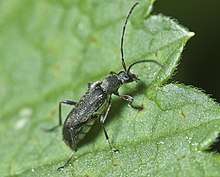Grammoptera ruficornis
Grammoptera ruficornis is a species of beetle in family Cerambycidae.
| Grammoptera ruficornis | |
|---|---|
 | |
| Grammoptera ruficornis. Male | |
 | |
| Female | |
| Scientific classification | |
| Kingdom: | |
| Phylum: | |
| Class: | |
| Order: | |
| Family: | |
| Genus: | |
| Species: | G. ruficornis |
| Binomial name | |
| Grammoptera ruficornis (Fabricius, 1781) [1] | |
| Synonyms[2] | |
|
List
| |
Etymology
The Latin scientific name ruficornis of this species means "with red antennae".
Subspecies
Subspecies include:[2]
- Grammoptera ruficornis subsp. flavipes Pic, 1892
- Grammoptera ruficornis subsp. ruficornis (Fabricius, 1781)
Distribution
This species can be found in the Palearctic ecozone. It is present in most of Europe (Albania, Austria, Belarus, Belgium, Bosnia and Herzegovina, Bulgaria, Croatia, Czech Republic, Denmark, Estonia, France, Germany, Greece, Hungary, Ireland, Italy, Latvia, Lithuania, Luxembourg, Moldova, Montenegro, Netherlands, Norway, Poland, Portugal, Romania, Russia, Serbia, Slovakia, Slovenia, Spain, Sweden, Switzerland, Ukraine and United Kingdom), in Caucasus, Transcaucasia, Turkey, Azerbaijan and Iran. [3] [4]
Habitat
These longhorns are linked to deciduous forest and they occur in forests, glades, pastures and old deciduous trees. In the Alps they rarely exceed an elevation of 1,000 metres (3,300 ft) above sea level.
Description
Grammoptera ruficornis can reach a body length of about 3–7 mm (0.12–0.28 in). Females are longer and wider than males. These small longicorns have a stretched and densely punctate body (pronotum and elytra), not very narrow at the back, with silky hairs on the elytra. Eyes are rather close to the jaw base. The color is dark brown or black, with long yellow-red antennae that are almost as long as the body and show an elongate 2nd segment. Also the legs are partly yellowish red, with bulbous bicoloured femora, but hind femora sometimes are entirely black. [5][6]
Biology
Adults are found feeding on Carolina buckthorn (Rhamnus cathartica), European beech (Fagus sylvatica), Alder buckthorn (Frangula alnus), Pedunculate oak (Quercus robur) and Manna Ash (Fraxinus ornus), Buck's-beard (Aruncus dioicus), Ground-elder (Aegopodium podagraria), hawthorn (Crataegus monogyna), Anthriscus and Rosa canina in Spring and Summer. The larvae develop in fungi infested dead branches of deciduous trees. [2] The larval development is annual and the adult hatches from the end of May to the middle of June. The adults are usually seen in flowers of hawthorn Crataegus monogyna, rowan (Sorbus aucuparia), whitebeam (Sorbus intermedia), cow parsley (Anthriscus sylvestris) and Apiaceae.
Some parasitoid's (Dolichomitus agnoscendus, Ichneumonidae and Cenocoelius aartseni, Braconidae) live in close association with these longhorns. [2]
Gallery
- Mating couple
_(3636411046).jpg) Mounted specimen
Mounted specimen
External links
References
| Wikispecies has information related to Grammoptera ruficornis |
| Wikimedia Commons has media related to Grammoptera ruficornis. |
- Fabricius, J.C. 1781. Species insectorum; exhibentes eorum differentias specificas, synonyma, auctorum, loca natalia, metamorphosin ediectis observationibus, descriptionibus. Carol. Ernest. Bohnii, Hamburgi et Kilonii, vol 1: VIII + 552 pp
- Biolib
- Joy, N 1932 A Practical Handbook of British Beetles
- Fauna Europaea
- Kerfdier
- thewcg.org